
Introduction
ASCII characters (between U+0020 and U+007F)
Latin one (between U+00A0 and U+00FF)
Latin extended-A (between U+0100 and U+017F)
Latin extended-B (between U+0180 and U+024F) [todo]
IPA Extensions (between U+0250 and U+02AF) [todo]
Greek, etc (between U+0370 and U+03FF) [todo]
Cyrillic, etc (between U+0400 and U+04FF) [todo]
Latin Extended Additional (between U+1E00 and U+1EFF)
Arrows (between U+2190 and U+21FF)
Mathematical Operators (between U+2200 and U+22FF)
Miscellaneous Technical (between U+2300 and U+23FF) [with holes]
Miscellaneous Symbols (between U+2600 and U+26FF) [with holes]
Dingbats (between U+2700 and U+27BF)
Mathematical Alphanumeric Symbols (between U+1D400 and U+1D5FF)
The T1 encoding
This file explains how to produce all characters defined by the Unicode standard, and even more. In earlier versions; Tralics used internally the iso-8859-1 encoding, and this is the default input encoding; you could tell Tralics that the text is encoded in UTF-8 format, this meant that some characters were converted into a sequence of the form \char567{} (this is read as a sequence of six tokens). The internal encoding is now Unicode.
UTF-8 is a variable length format; each character consists in one to four bytes, A, AB, ABC, or ABCD, depending of the first byte. If the first bit of A is zero, so that A is an integer between 0 and 127, then one byte is used, and the value is A. Thus, an ASCII character represents itself in UTF8. Otherwise, A starts with 2, 3 or 4 bits equal to 1, and is followed by a zero bit, followed by some useful bits (say `a'). The total number of bytes is 2, 3 or 4, respectively, each byte B, C, D starts with a bit equal to 1 , and a bit equal to 0, and is followed by 6 useful bits, say `b', or `c', or `d'; the value of the character is `ab', `abc' or `abcd'. Thus, using 2, 3 or 4 bytes, we can represent 11, 16, or 21 bits. When a line of text is read from a file, it is converted to UTF8; at the end of the run, you may see something like Input conversion: 14 lines converted. This means that almost all lines contained only ASCII characters.
A construction like \char1000 means: insert the character number 1000 in the XML tree. The character must fit on 27 bits. A construction like ^^ab (two lower case hex chars) can be used to represent a 8bit character, and a construction like ^^^^abcd (four lower case hex chars) can be used to represent a 16bit character. You can also use five hats as in ^^^^^1d7e0 (this is Unicode Mathematical Double-struck Digit Eight). An hex char is a digit or a lower case letter between `a' and `f'. You can say ^^Z, where `Z' can be replaced by any 7bit character, except a hat or a hex char; if this case Tralics adds or subtracts 64, the result is a 7bit character. For instance ^^Z is the character with code 26, ^^@ is the null character, ^^? the delete character, ^^M is the end of line character (in the input stream), ^^J is the end of line character (in the output stream).
An important property of a character is its category code. In
plain TeX some characters have category code ignore
or invalid
,
this explains why the constructions ^^?
and ^^@ are so useful. When Tralics parses a
control sequence like \foo, then either the character
that follows the backslash has category letter
and all letters
that follow are scanned and a following space is usually ignored, or
the command name has only one character. In the case of
\fée, the result is a
1-character command (it tries to put an accent on the character that follows).
You can say \catcode`é=11\def\fée{fairy}, and then use the
command \fée.
All tables that hold character properties are of size 65536; this excludes
characters that need 4 UTF8 bytes, but includes all characters that can be
constructed via the double-hat or four-hat construction. In particular
\catcode`^^^^^1d7e0=11 is an error. What the command
really gets is the following sequence of tokens: \char"1D7E0, a command followed by 6 character tokens category 12.
If you say
\def\f^^^^^1d7e0{xx}\def\^^^^^1d7e0{xx},
the hat conversion algorithm is applied; in the first definition, you get a
command named \f, that has to be followed by some
character (note that \f\char"1D7E0 is an error,
since the category code of the letteres are 11, but 12 is expected).
The second definition confuses the parser: what follows the
backslash has no category code, so the name of the command is empty,
and this empty command has to be followed the character;
so \^^^^^1d7e1, provokes the following error
Use of \csname\endcsname doesn't match its definition.
You can use one of -oe8, -oe1, -oe8a, -oe1a as option to Tralics for controlling the encoding used in the XML file. If the option is -oe8 or -oe8a, then the declaration is encoding='UTF-8', otherwise it is encoding='iso-8859-1'. Assume that the input is \char16\char65\char233\char378\char1064\char10774\char120587. The translation is AéźШ⨖𝜋 (the first character being illegal in HTLK, it is not shown here). If the option is -oe8 (the default), the first and last characters are encoded as  and 𝜋, the others are in UTF8; the transcript file will contain the same string. If the option is -oe8a, all characters but ASCII ones will be output in the form é, the transcript file will contain A^^e9^^^^017a^^^^0428^^^^2a16𝜋. If the option is -oe1a, the contents will be the same, except for the encoding of the file. Finally, if the option is -oe1, the output is the same, except for characters whose code is between 128 and 255, that will be printed on one byte.
You can use one of -te8, -te1, -te8a, -te1a as option for controlling the encoding used in the transcript file, without the XML file. This encoding also used when Tralics prints something on the terminal. For instance, this is the output of \show, with the option te1a: \f^^e9e=macro: ->fairy.
You can use one of -utf8, -latin1 for indicating the default input encoding. In LaTeX, you can use the inputenc package for specifying alternate encodings, this is not yet implemented. All files are converted into UTF-8 while they are read; there is an exception: the main file is converted only after the configuration file has been read (this means that the configuration file could contain the definition of the encoding). You can declare the encoding of the current file, by putting near the head of the file a line that contains -*- followed by coding: iso-8859-1 or coding: utf8. This works whatever the type of the file: configuration file, bibliography data base, or TeX file.
A given character can appear in one of three modes: typesetting text, typesetting maths, and other cases (in general, when creating the name of an element, of an attribute, the name of a file to be opened, etc). In the case of \input{xx}, the characters that are valid are system dependent, and Tralics accepts only latin1 characters, without further tests. In the same fashion, \xbox{á b}{\AddAttToCurrent{x=}{y}z} generates an XML element that contains a space in its name, and an attribute name that contains an equals sign. This is illegal, but not refused. If you say \xbox{x\xmllatex{\&\#x5678;}{}y}{} the result is an empty XML with a funny name: <x噸y/>.
In math mode, each character is classified as an identifier, a number, or an operator (such an element can consist of more than one character). Hence the translation of $x=1$ is: <mi>x</mi><mo>=</mo><mn>1</mn>. There is a built-in table that explains the type of every ASCII character. Non-ASCII latin1 characters are all considered as operators if their code is between 128 and 191, as identifiers otherwise. Thus, the translation of $±á$ is <mo>±</mo><mi>á</mi>. There is a large number of commands whose translation is a Unicode character. LaTeX makes a distinction between those that can be used in math, or outside math; this restriction has sometimes been removed. For instance \textohm is the same as ^^^^2126, and the following expression \xbox{\textohm b}{\textohm$\textohm$} is valid. The math formula contains an identifier.
If you say \mathchardef\foo1234, then TeX interprets \foo as \mathchar1234. See the TeX book for what character this produces. For simplicity, Tralics interprets this as \char1234; this is the character number 1234 (Unicode U+4D2, some Cyrillic character. Any 27 bit character can be used in this way. A command like \Omega can be used only in math mode. The translation is an identifier (but most math symbols are operators), the value is Ω. If the option -noentnames has been given, then translation is Ω. Translation of \mathbb A is 𝔸 or 𝍘. If you specify the mathvariant option, then translation changes to <mi mathvariant='double-struck'>A</mi>.
In text mode, there are different ways to obtain a character, and they are all valid. For instance, if you want a acute, you can say á (latin1 or UTF8 input) or \char`\á \char"E1 (two variants of the \char command) or \'a \a'a (two variants of the accent command) or \xmllatex{\&\#xE1;}{} \xmllatex{\á}{} (two variants of the \xmllatex command that refers to a Unicode character via an entity).
Printing characters with code between 33 and 126 is not complicated. Character 32 is space, it is impossible to tell the difference between a cell that contains only space and an empty space. Character 127 is delete, it cannot be printed. For some strange reason, LaTeX provides no way for printing a hat or a tilde. This is why \char is used in the table below.
\begin{tabular}{cccccccccccccccc}
&!&"&\#&\$&\%&\&&'&(&)&*&+&,&-&.&/\\
0&1&2&3&4&5&6&7&8&9&:&;&<&=&>&?\\
@&A&B&C&D&E&F&G&H&I&J&K&L&M&N&O\\
P&Q&R&S&T&U&V&W&X&Y&Z&[&\textbackslash&]&\char`\^&\_\\
`&a&b&c&d&e&f&g&h&i&j&k&l&m&n&o\\
p&q&r&s&t&u&v&w&x&y&z&\{&|&\}&\char`\~&
\end{tabular}
The translation is trivial. We only show the preview (LaTeX image) and the
HTML characters.

| ! | " | # | $ | % | & | ' | ( | ) | * | + | , | - | . | / | |
| 0 | 1 | 2 | 3 | 4 | 5 | 6 | 7 | 8 | 9 | : | ; | < | = | > | ? |
| @ | A | B | C | D | E | F | G | H | I | J | K | L | M | N | O |
| P | Q | R | S | T | U | V | W | X | Y | Z | [ | \ | ] | ^ | _ |
| ` | a | b | c | d | e | f | g | h | i | j | k | l | m | n | o |
| p | q | r | s | t | u | v | w | x | y | z | { | | | } | ~ |
These are all the characters with code between x80 and xFF. In fact, characters in the range x80 and x9F are not printable. Character A0 is a space, character AD is a discretionary hyphen.
\begin{tabular}{cccccccccccccccc}
~&¡&¢&£&¤&¥&¦&§&¨&©&ª&«&¬&&®&¯\\
°&±&²&³&´&µ&¶&·&¸&¹&º&»&¼&½&¾&¿\\
À&Á&Â&Ã&Ä&Å&Æ&Ç&È&É&Ê&Ë&Ì&Í&Î&Ï\\
Ð&Ñ&Ò&Ó&Ô&Õ&Ö&×&Ø&Ù&Ú&Û&Ü&Ý&Þ&ß\\
à&á&â&ã&ä&å&æ&ç&è&é&ê&ë&ì&í&î&ï\\
ð&ñ&ò&ó&ô&õ&ö&÷&ø&ù&ú&û&ü&ý&þ&ÿ\\
\end{tabular}
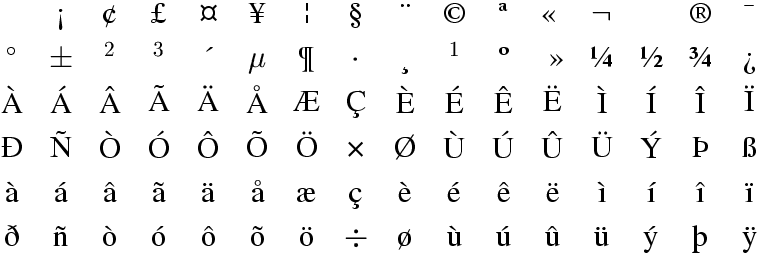
| ¡ | ¢ | £ | ¤ | ¥ | ¦ | § | ¨ | © | ª | « | ¬ | | ® | ¯ | |
| ° | ± | ² | ³ | ´ | µ | ¶ | · | ¸ | ¹ | º | » | ¼ | ½ | ¾ | ¿ |
| À | Á | Â | Ã | Ä | Å | Æ | Ç | È | É | Ê | Ë | Ì | Í | Î | Ï |
| Ð | Ñ | Ò | Ó | Ô | Õ | Ö | × | Ø | Ù | Ú | Û | Ü | Ý | Þ | ß |
| à | á | â | ã | ä | å | æ | ç | è | é | ê | ë | ì | í | î | ï |
| ð | ñ | ò | ó | ô | õ | ö | ÷ | ø | ù | ú | û | ü | ý | þ | ÿ |
Seven bit input for the same characters.
\begin{tabular}{cccccccccccccccc}
\nobreakspace&\textexclamdown&\textcent&\textsterling&\textcurrency&\textyen&
\textbrokenbar&\textsection&\textasciidieresis&\textcopyright&
\textordfeminine&\guillemotleft&\textlnot&\textsofthyphen&
\textregistered&\textasciimacron\\
\textdegree&\textpm&\texttwosuperior&\textthreesuperior&\textasciiacute&
\textmu&\textparagraph&\textperiodcentered&\textasciicedilla&
\textonesuperior&\textordmasculine&\guillemotright&\textonequarter&
\textonehalf&\textthreequarters&\textquestiondown\\
\`A&\'A&\^A&\~A&\quot;A&\AA&\AE&\c C&\`E&\'E&\^E&\"E&\`I&\'I&\^I&\"I\\
\DH&\~N&\`O&\'O&\^O&\~O&\"O&\texttimes&\O&\`U&\'U&\^U&\"U&\'Y&\TH&\ss\\
\`a&\'a&\^a&\~a&\"a&\aa&\ae&\c c&\`e&\'e&\^e&\"e&\`i&\'i&\^i&\"i\\
\dh&\~n&\`o&\'o&\^o&\~o&\"o&\textdiv&\o&\`u&\'u&\^u&\"u&\'y&\th&\"y\\
\end{tabular}
Notes: \textsection=\S, \textparagraph=\P, \textcopyright =\copyright. Concerning French guillemets, you can use \og, that produces a guillemet and a space, or \guillemotleft that produces only the guillemet, or « or (if the current language is French) << that produce intelligent guillemets: a space is removed if there is one, then another one is added. Example
{\language=1 a\fg{}b\og{}c\guillemotleft{}d\guillemotright{}e}
{\language=0 a\fg{}b\og{}c\guillemotleft{}d\guillemotright{}e}
{\language=1 a<<b<< c<<~d<<\,e\,>>f~>>g >>h>>i}
{\language=0 a<<b<< c<<~d<<\,e\,>>f~>>g >>h>>i}
{\language=1 a«b« c«~d«\,e\,»f~»g »h»i}
{\language=0 a«b« c«~d«\,e\,»f~»g »h»i}
Translation (we replaced character U+A0 by an entity, in order to distinguish it from a space).
a »b« c« d »e a »b« c«d»e a« b« c«  d« e  »f  »g »h »i a<<b<< c<< d<< e >>f >>g >>h>>i a« b« c«  d« e  »f  »g »h »i a«b« c« d« e »f »g »h»i
These are all the characters with code between U+100 and U+17F.
\def\nument#1{\xmllatex{\&\#x#1;}{}}
\begin{tabular}{cccccccccccccccc}
\=A&\=a& \u A&\u a&\k A&\k a&\'C&\'c&\^C&\^c&\.C&\.c&\v C&\v c&\v D&\v d \\
\DJ&\dj&\=E&\=e&\u E&\u e&\.E&\.e&\k E&\k e&\v E&\v e&\^G&\^g&\u G&\u g\\
\.G&\.g&\c G&\c g&\^H&\^h&\=H&\=h&\~I&\~i&\=I&\=i&\u I&\u i&\k I&\k i\\
\.I&\i&\IJ&\ij&\^J&\^j&\c K&\c k&\nument{138}&\'L&\'l&\c L&\c l&\v L&\v l&\.L\\
\.l&\L&\l&\'N&\'n&\c N&\c n&\v N&\v n&\nument{149}&\NG&\ng&\=O&\=o&\u O&\u o\\
\H O&\H o&\OE&\oe&\'R&\'r&\c R&\c r&\v R&\v r&\'S&\'s&\^S&\^s&\c S&\c s&\\
\v S&\v s&\c T&\c t&\v T&\v t&\=T&\=t&\~U&\~u&\=U&\=u&\u U&\u u&\r U&\r u\\
\H U&\H u&\k U&\k u&\^W&\^w&\^Y&\^y&\"Y&\'Z&\'z&\.Z&\.z&\v Z&\v z&\nument{17F}\\
\end{tabular}
Characters U+138, U+149 and U+17F have no name in Tralics. The first one is: `latin small letter kra', the second is `latin small letter n preceded by apostrophe', and the last is `latin small letter long s'.
This is the XML translation, without the `tabular'.
Ā ā Ă ă Ą ą Ć ć Ĉ ĉ Ċ ċ Č č Ď ď Đ đ Ē ē Ĕ ĕ Ė ė Ę ę Ě ě Ĝ ĝ Ğ ğ Ġ ġ Ģ ģ Ĥ ĥ Ħ ħ Ĩ ĩ Ī ī Ĭ ĭ Į į İ ı IJ ij Ĵ ĵ Ķ ķ ĸ Ĺ ĺ Ļ ļ Ľ ľ Ŀ ŀ Ł ł Ń ń Ņ ņ Ň ň ʼn Ŋ ŋ Ō ō Ŏ ŏ Ő ő Œ œ Ŕ ŕ Ŗ ŗ Ř ř Ś ś Ŝ ŝ Ş ş Š š Ţ ţ Ť ť Ŧ ŧ Ũ ũ Ū ū Ŭ ŭ Ů ů Ű ű Ų ų Ŵ ŵ Ŷ ŷ Ÿ Ź ź Ż ż Ž ž ſ
As you can see, translation is trivial. In the initial version of the software, there was a possibility to obtain entity names.
| Ā | ā | Ă | ă | Ą | ą | Ć | ć | Ĉ | ĉ | Ċ | ċ | Č | č | Ď | ď | |
| Đ | đ | Ē | ē | Ĕ | ĕ | Ė | ė | Ę | ę | Ě | ě | Ĝ | ĝ | Ğ | ğ | |
| Ġ | ġ | Ģ | ģ | Ĥ | ĥ | Ħ | ħ | Ĩ | ĩ | Ī | ī | Ĭ | ĭ | Į | į | |
| İ | ı | IJ | ij | Ĵ | ĵ | Ķ | ķ | ĸ | Ĺ | ĺ | Ļ | ļ | Ľ | ľ | Ŀ | |
| ŀ | Ł | ł | Ń | ń | Ņ | ņ | Ň | ň | ʼn | Ŋ | ŋ | Ō | ō | Ŏ | ŏ | |
| Ő | ő | Œ | œ | Ŕ | ŕ | Ŗ | ŗ | Ř | ř | Ś | ś | Ŝ | ŝ | Ş | ş | |
| Š | š | Ţ | ţ | Ť | ť | Ŧ | ŧ | Ũ | ũ | Ū | ū | Ŭ | ŭ | Ů | ů | |
| Ű | ű | Ų | ų | Ŵ | ŵ | Ŷ | ŷ | Ÿ | Ź | ź | Ż | ż | Ž | ž | ſ |
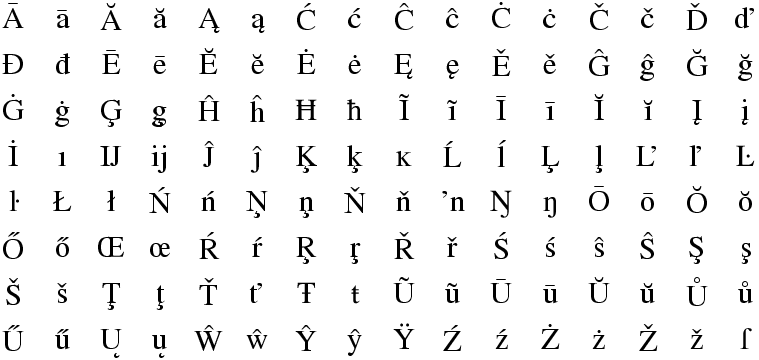
We explain here how to obtain all characters between U+1E00 and U+1EFF. Character U+1e9a (latin small letter a with right half ring) is not implemented. There are two holes in the tables: of 4 and 6 characters respectively.
\def\xx#1{\xmllatex{\&\#x#1;}{}}
\catcode`\&13\def&{ }
\D A &\D a&\.B&\.b &\d B&\d b&\b B&\b b& \'{\c C} &\'{\c c}&
\.D &\.d &\d D& \d d &\b D &\b d\\
\c D &\c d& \V D& \V d &\`{\=E}& \`{\=e} &\'{\=E}&\'{\=e}&
\V E &\V e &\T E& \T e& \u{\c E}& \u{\c e}& \.F &\.f\\
\=G &\=g& \.H &\.h& \d H&\d h&\"H &\" h&\c H&\c h&\xx{1e2a}&\xx{1e2b}
&\T I&\T i&\'{\"I}&\'{\"i}\\
\'K&\'k&\d K&\d k& \b K&\b k&\d L&\d l&\={\d L}&\={\d l}&\b L&\b l&\V L
&\V l&\'M&\'m \\
\.M&\.m&\d M&\d m&\.N&\.n&\d N&\d n&\b N&\b n&\V N&\V n&\~{\'O}&\~{\'o}
&\~{\"O}&\~{\"o}\\
\`{\=O}&\`{\=o}&\'{\=O}&\'{\=o}&\'P&\'p&\.P&\.p&\. R&\. r&\d R&\d r&
\={\d R}&\={\d r}&\b R&\b r\\
\.S&\.s&\d S&\d s&\.{\'S}&\.{\'s}&\v{\.S}&\v{\.s}&\d{\.S}&\d{\.s}
&\.T&\. t&\d T&\d t&\b T&\b t\\
\V T&\V t&\xx{1e72}&\xx{1e73}&\T U&\T u&\V U&\V u&\~{\'U}&\~{\'u}&
\={\"U}&\={\"u}&\~V&\~v&\d V&\d v\\
Translation
<p>Ḁ ḁ Ḃ ḃ Ḅ ḅ Ḇ ḇ Ḉ ḉ Ḋ ḋ Ḍ ḍ Ḏ ḏ</p><p noindent='true'> Ḑ ḑ Ḓ ḓ Ḕ ḕ Ḗ ḗ Ḙ ḙ Ḛ ḛ Ḝ ḝ Ḟ ḟ</p><p noindent='true'> Ḡ ḡ Ḣ ḣ Ḥ ḥ Ḧ ḧ Ḩ ḩ ḪḫḬ ḭ Ḯ ḯ</p><p noindent='true'> Ḱ ḱ Ḳ ḳ Ḵ ḵ Ḷ ḷ Ḹ ḹ Ḻ ḻ Ḽ ḽ Ḿ ḿ</p><p noindent='true'> Ṁ ṁ Ṃ ṃ Ṅ ṅ Ṇ ṇ Ṉ ṉ Ṋ ṋ Ṍ ṍ Ṏ ṏ</p><p noindent='true'> Ṑ ṑ Ṓ ṓ Ṕ ṕ Ṗ ṗ Ṙ ṙ Ṛ ṛ Ṝ ṝ Ṟ ṟ</p><p noindent='true'> Ṡ ṡ Ṣ ṣ Ṥ ṥ Ṧ ṧ Ṩ ṩ Ṫ ṫ Ṭ ṭ Ṯ ṯ</p><p noindent='true'> Ṱ ṱ ṲṳṴ ṵ Ṷ ṷ Ṹ ṹ Ṻ ṻ Ṽ ṽ Ṿ ṿ</p>
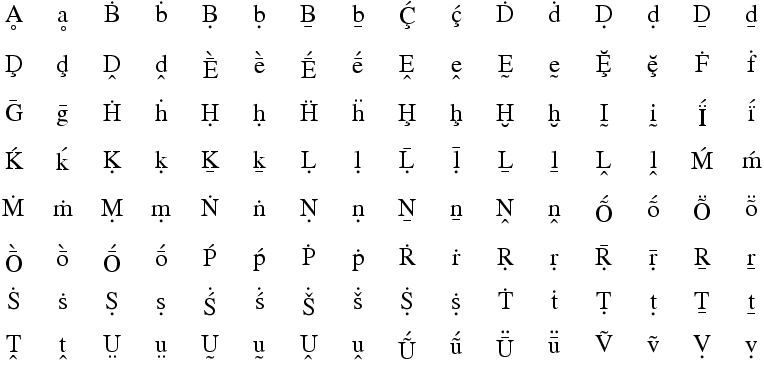
| Ḁ | ḁ | Ḃ | ḃ | Ḅ | ḅ | Ḇ | ḇ | Ḉ | ḉ | Ḋ | ḋ | Ḍ | ḍ | Ḏ | ḏ |
| Ḑ | ḑ | Ḓ | ḓ | Ḕ | ḕ | Ḗ | ḗ | Ḙ | ḙ | Ḛ | ḛ | Ḝ | ḝ | Ḟ | ḟ |
| Ḡ | ḡ | Ḣ | ḣ | Ḥ | ḥ | Ḧ | ḧ | Ḩ | ḩ | Ḫ | ḫ | Ḭ | ḭ | Ḯ | ḯ |
| Ḱ | ḱ | Ḳ | ḳ | Ḵ | ḵ | Ḷ | ḷ | Ḹ | ḹ | Ḻ | ḻ | Ḽ | ḽ | Ḿ | ḿ |
| Ṁ | ṁ | Ṃ | ṃ | Ṅ | ṅ | Ṇ | ṇ | Ṉ | ṉ | Ṋ | ṋ | Ṍ | ṍ | Ṏ | ṏ |
| Ṑ | ṑ | Ṓ | ṓ | Ṕ | ṕ | Ṗ | ṗ | Ṙ | ṙ | Ṛ | ṛ | Ṝ | ṝ | Ṟ | ṟ |
| Ṡ | ṡ | Ṣ | ṣ | Ṥ | ṥ | Ṧ | ṧ | Ṩ | ṩ | Ṫ | ṫ | Ṭ | ṭ | Ṯ | ṯ |
| Ṱ | ṱ | Ṳ | ṳ | Ṵ | ṵ | Ṷ | ṷ | Ṹ | ṹ | Ṻ | ṻ | Ṽ | ṽ | Ṿ | ṿ |
\catcode`\&13\def&{ }
\`W&\`w&\'W&\'w&\"W&\"w&\.W&\.w&\d W&\d w&\. X&\. x&\"X&\"x&\. Y&\.y\\
\^Z&\^z&\d Z&\d z&\b Z&\b z&\b h&\" t&\r
w&\r y&?&\xx{1e9b}\\
\d A&\d a&\h A&\h a&\^{\'A}&\^{\'a}&\^{\`A}&\^{\`a}&{\^{\h A}}&\^{\h a}&
\~{\^A}&\~{\^a}&\d{\^A}&\d{\^a}&\'{\u A}&\'{\u a}\\
\`{\u A}&\`{\u a}&\h{\u A}&\h{\u a}&\~{\u A}&\~{\u a}&\d{\u A}&\d{\u a}&\d E&
\d e&\h E&\h e&\~ E&\~e&\'{\^E}&\'{\^e}\\
\^{\`E}&\^{\`e}&\^{\h E}&\^{\h e}&\~{\^E}&\~{\^e}&\^{\d E}&\^{\d e}&\h I&
\h i&\d I&\d i& \d O &\d o&\h O&\h o\\
\'{\^O}&\'{\^o}&\`{\^O}&\`{\^o}&\^{\h O}&\^{\h o}&\~{\^O}&\~{\^o}&
\^{\d O}&\^{\d o}&\'{\H O}&\'{\H o}&\`{\H O}&\`{\H o}&\h{\H O}&\h{\H o}\\
\~{\H O}&\~{\H o}&\d{\H O}&\d{\H o}&\d U&\d u&\h U&\h u&\'{\H U}&\'{\H u}&
\`{\H U}&\`{\H u}&\h{\H U}&\h{\H u}&\~{\H U}&\~{\H u}\\
\H{\d U}&\H{\d u}&\` Y&\` y&\d Y&\d y&\h Y&\h y&\~ Y&\~y
<p> Ẁ ẁ Ẃ ẃ Ẅ ẅ Ẇ ẇ Ẉ ẉ Ẋ ẋ Ẍ ẍ Ẏ ẏ</p><p noindent='true'> Ẑ ẑ Ẓ ẓ Ẕ ẕ ẖ ẗ ẘ ẙ ? ẛ</p><p noindent='true'> Ạ ạ Ả ả Ấ ấ Ầ ầ Ẩ ẩ Ẫ ẫ Ậ ậ Ắ ắ</p><p noindent='true'> Ằ ằ Ẳ ẳ Ẵ ẵ Ặ ặ Ẹ ẹ Ẻ ẻ Ẽ ẽ Ế ế</p><p noindent='true'> Ề ề Ể ể Ễ ễ Ệ ệ Ỉ ỉ Ị ị Ọ ọ Ỏ ỏ</p><p noindent='true'> Ố ố Ồ ồ Ổ ổ Ỗ ỗ Ộ ộ Ớ ớ Ờ ờ Ở ở</p><p noindent='true'> Ỡ ỡ Ợ ợ Ụ ụ Ủ ủ Ứ ứ Ừ ừ Ử ử Ữ ữ</p><p noindent='true'> Ự ự Ỳ ỳ Ỵ ỵ Ỷ ỷ Ỹ ỹ</p>
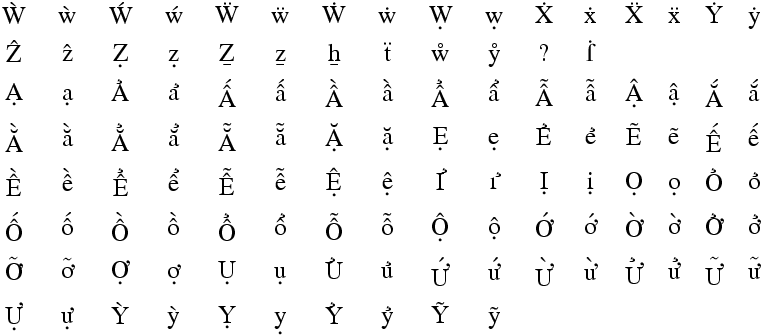
| Ẁ | ẁ | Ẃ | ẃ | Ẅ | ẅ | Ẇ | ẇ | Ẉ | ẉ | Ẋ | ẋ | Ẍ | ẍ | Ẏ | ẏ |
| Ẑ | ẑ | Ẓ | ẓ | Ẕ | ẕ | ẖ | ẗ | ẘ | ẙ | ? | ẛ | ||||
| Ạ | ạ | Ả | ả | Ấ | ấ | Ầ | ầ | Ẩ | ẩ | Ẫ | ẫ | Ậ | ậ | Ắ | ắ |
| Ằ | ằ | Ẳ | ẳ | Ẵ | ẵ | Ặ | ặ | Ẹ | ẹ | Ẻ | ẻ | Ẽ | ẽ | Ế | ế |
| Ề | ề | Ể | ể | Ễ | ễ | Ệ | ệ | Ỉ | ỉ | Ị | ị | Ọ | ọ | Ỏ | ỏ |
| Ố | ố | Ồ | ồ | Ổ | ổ | Ỗ | ỗ | Ộ | ộ | Ớ | ớ | Ờ | ờ | Ở | ở |
| Ỡ | ỡ | Ợ | ợ | Ụ | ụ | Ủ | ủ | Ứ | ứ | Ừ | ừ | Ử | ử | Ữ | ữ |
| Ự | ự | Ỳ | ỳ | Ỵ | ỵ | Ỷ | ỷ | Ỹ | ỹ |
You can use the \ding command in order to access one character of the Zapf Dingbats fonts. The command takes one argument, an integer (it is parsed by the scanint routine, see scanint for details, so that \ding{`\A} is as valid as \char`\A). If the number is between 33 and 126, or between 161 and 239, or between 241 and 254, then you get one of the characters listed below. Otherwise, the translation is bad!
Example that shows the complete list.
{\LARGE
\begin{tabular}{cccccccccccccccc}
%\catcode`\&13\def&{ }
&\ding{"21}&\ding{"22}&\ding{"23}&\ding{"24}&\ding{"25}&\ding{"26}&\ding{"27}&
\ding{"28}&\ding{"29}&\ding{"2A}&\ding{"2B}&\ding{"2C}&\ding{"2D}&\ding{"2E}&\ding{"2F}\\
\ding{"30}&\ding{"31}&\ding{"32}&\ding{"33}&\ding{"34}&\ding{"35}&\ding{"36}&\ding{"37}&
\ding{"38}&\ding{"39}&\ding{"3A}&\ding{"3B}&\ding{"3C}&\ding{"3D}&\ding{"3E}&\ding{"3F}\\
\ding{"40}&\ding{"41}&\ding{"42}&\ding{"43}&\ding{"44}&\ding{"45}&\ding{"46}&\ding{"47}&
\ding{"48}&\ding{"49}&\ding{"4A}&\ding{"4B}&\ding{"4C}&\ding{"4D}&\ding{"4E}&\ding{"4F}\\
\ding{"50}&\ding{"51}&\ding{"52}&\ding{"53}&\ding{"54}&\ding{"55}&\ding{"56}&\ding{"57}&
\ding{"58}&\ding{"59}&\ding{"5A}&\ding{"5B}&\ding{"5C}&\ding{"5D}&\ding{"5E}&\ding{"5F}\\
\ding{"60}&\ding{"61}&\ding{"62}&\ding{"63}&\ding{"64}&\ding{"65}&\ding{"66}&\ding{"67}&
\ding{"68}&\ding{"69}&\ding{"6A}&\ding{"6B}&\ding{"6C}&\ding{"6D}&\ding{"6E}&\ding{"6F}\\
\ding{"70}&\ding{"71}&\ding{"72}&\ding{"73}&\ding{"74}&\ding{"75}&\ding{"76}&\ding{"77}&
\ding{"78}&\ding{"79}&\ding{"7A}&\ding{"7B}&\ding{"7C}&\ding{"7D}&\ding{"7E}&\\
&\ding{"A1}&\ding{"A2}&\ding{"A3}&\ding{"A4}&\ding{"A5}&\ding{"A6}&\ding{"A7}&
\ding{"A8}&\ding{"A9}&\ding{"AA}&\ding{"AB}&\ding{"AC}&\ding{"AD}&\ding{"AE}&\ding{"AF}\\
\ding{"B0}&\ding{"B1}&\ding{"B2}&\ding{"B3}&\ding{"B4}&\ding{"B5}&\ding{"B6}&\ding{"B7}&
\ding{"B8}&\ding{"B9}&\ding{"BA}&\ding{"BB}&\ding{"BC}&\ding{"BD}&\ding{"BE}&\ding{"BF}\\
\ding{"C0}&\ding{"C1}&\ding{"C2}&\ding{"C3}&\ding{"C4}&\ding{"C5}&\ding{"C6}&\ding{"C7}&
\ding{"C8}&\ding{"C9}&\ding{"CA}&\ding{"CB}&\ding{"CC}&\ding{"CD}&\ding{"CE}&\ding{"CF}\\
\ding{"D0}&\ding{"D1}&\ding{"D2}&\ding{"D3}&\ding{"D4}&\ding{"D5}&\ding{"D6}&\ding{"D7}&
\ding{"D8}&\ding{"D9}&\ding{"DA}&\ding{"DB}&\ding{"DC}&\ding{"DD}&\ding{"DE}&\ding{"DF}\\
\ding{"E0}&\ding{"E1}&\ding{"E2}&\ding{"E3}&\ding{"E4}&\ding{"E5}&\ding{"E6}&\ding{"E7}&
\ding{"E8}&\ding{"E9}&\ding{"EA}&\ding{"EB}&\ding{"EC}&\ding{"ED}&\ding{"EE}&\ding{"EF}\\
&\ding{"F1}&\ding{"F2}&\ding{"F3}&\ding{"F4}&\ding{"F5}&\ding{"F6}&\ding{"F7}&
\ding{"F8}&\ding{"F9}&\ding{"FA}&\ding{"FB}&\ding{"FC}&\ding{"FD}&\ding{"FE}&\\
\end{tabular}
}
Translation, without the table and the font change. As you can see, the codes are between U+2700 and U+27BF, with some exceptions. For instance character 169 gives U+2666. This is black diamond suit. But the file mmlalias.ent defines ♦ to be the same character, and this is used to translate $\diamondsuit$.
<p>✁ ✂ ✃ ✄ ☎ ✆ ✇ ✈ ✉ ☛ ☞ ✌ ✍ ✎ ✏</p> <p noindent='true'>✐ ✑ ✒ ✓ ✔ ✕ ✖ ✗ ✘ ✙ ✚ ✛ ✜ ✝ ✞ ✟</p> <p noindent='true'>✠ ✡ ✢ ✣ ✤ ✥ ✦ ✧ ★ ✩ ✪ ✫ ✬ ✭ ✮ ✯</p> <p noindent='true'>✰ ✱ ✲ ✳ ✴ ✵ ✶ ✷ ✸ ✹ ✺ ✻ ✼ ✽ ✾ ✿</p> <p noindent='true'>❀ ❁ ❂ ❃ ❄ ❅ ❆ ❇ ❈ ❉ ❊ ❋ ● ❍ ■ ❏</p> <p noindent='true'>❐ ❑ ❒ ▲ ▼ ◆ ❖ ◗ ❘ ❙ ❚ ❛ ❜ ❝ ❞ </p> <p noindent='true'> ❡ ❢ ❣ ❤ ❥ ❦ ❧ ♣ ♦ ♥ ♠ ① ② ③ ④</p> <p noindent='true'>⑤ ⑥ ⑦ ⑧ ⑨ ⑩ ❶ ❷ ❸ ❹ ❺ ❻ ❼ ❽ ❾ ❿</p> <p noindent='true'>➀ ➁ ➂ ➃ ➄ ➅ ➆ ➇ ➈ ➉ ➊ ➋ ➌ ➍ ➎ ➏</p> <p noindent='true'>➐ ➑ ➒ ➓ ➔ → ↔ ↕ ➘ ➙ ➚ ➛ ➜ ➝ ➞ ➟</p> <p noindent='true'>➠ ➡ ➢ ➣ ➤ ➥ ➦ ➧ ➨ ➩ ➪ ➫ ➬ ➭ ➮ ➯</p> <p noindent='true'> ➱ ➲ ➳ ➴ ➵ ➶ ➷ ➸ ➹ ➺ ➻ ➼ ➽ ➾ </p>
This is the table
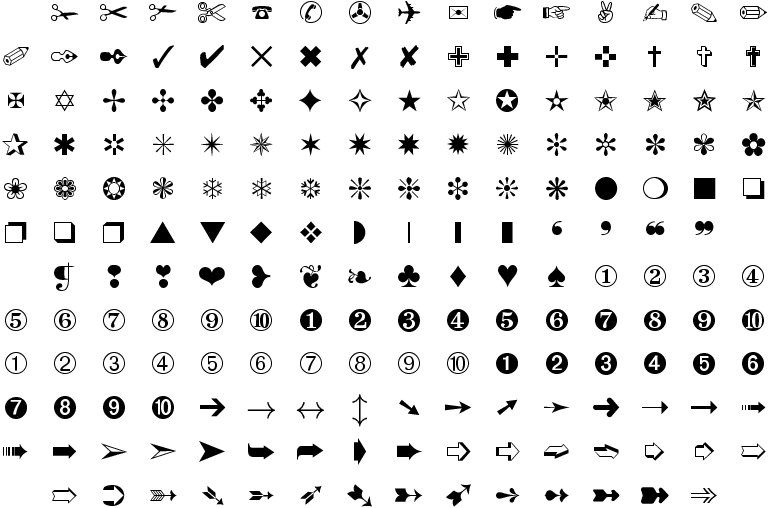
| ✁ | ✂ | ✃ | ✄ | ☎ | ✆ | ✇ | ✈ | ✉ | ☛ | ☞ | ✌ | ✍ | ✎ | ✏ | |
| ✐ | ✑ | ✒ | ✓ | ✔ | ✕ | ✖ | ✗ | ✘ | ✙ | ✚ | ✛ | ✜ | ✝ | ✞ | ✟ |
| ✠ | ✡ | ✢ | ✣ | ✤ | ✥ | ✦ | ✧ | ★ | ✩ | ✪ | ✫ | ✬ | ✭ | ✮ | ✯ |
| ✰ | ✱ | ✲ | ✳ | ✴ | ✵ | ✶ | ✷ | ✸ | ✹ | ✺ | ✻ | ✼ | ✽ | ✾ | ✿ |
| ❀ | ❁ | ❂ | ❃ | ❄ | ❅ | ❆ | ❇ | ❈ | ❉ | ❊ | ❋ | ● | ❍ | ■ | ❏ |
| ❐ | ❑ | ❒ | ▲ | ▼ | ◆ | ❖ | ◗ | ❘ | ❙ | ❚ | ❛ | ❜ | ❝ | ❞ | |
| ❡ | ❢ | ❣ | ❤ | ❥ | ❦ | ❧ | ♣ | ♦ | ♥ | ♠ | ① | ② | ③ | ④ | |
| ⑤ | ⑥ | ⑦ | ⑧ | ⑨ | ⑩ | ❶ | ❷ | ❸ | ❹ | ❺ | ❻ | ❼ | ❽ | ❾ | ❿ |
| ➀ | ➁ | ➂ | ➃ | ➄ | ➅ | ➆ | ➇ | ➈ | ➉ | ➊ | ➋ | ➌ | ➍ | ➎ | ➏ |
| ➐ | ➑ | ➒ | ➓ | ➔ | → | ↔ | ↕ | ➘ | ➙ | ➚ | ➛ | ➜ | ➝ | ➞ | ➟ |
| ➠ | ➡ | ➢ | ➣ | ➤ | ➥ | ➦ | ➧ | ➨ | ➩ | ➪ | ➫ | ➬ | ➭ | ➮ | ➯ |
| ➱ | ➲ | ➳ | ➴ | ➵ | ➶ | ➷ | ➸ | ➹ | ➺ | ➻ | ➼ | ➽ | ➾ |
Here is a list of commands that are known to Tralics but whose translation does not correspond to a Unicode character. Thus, an error is signaled.
%\textascendercompwordmark\textcapitalcompwordmark % \textlbrackdbl\textrbrackdbl\texttildelow\textleaf\textdivorced\textborn % \textquotestraightbase\textquotestraightdblbase\textmarried\textdied % \textinterrobangdown\textcopyleft\textdollaroldstyle\textdollaroldstyle % \textblank\textcentoldstyle\textcentoldstyle % \textcentoldstyle\textdblhyphen % \textfouroldstyle \textfiveoldstyle \texteightoldstyle\textnineoldstyle % \textoneoldstyle \textsevenoldstyle\textsixoldstyle % \textthreeoldstyle\textzerooldstyle \texttwooldstyle
Here is a list of commands whose name start with `text'.
\textacutedbl\ \textasciiacute\ \textasciiacutex\ \textasciibreve\ \textasciicaron\ \textasciicedilla\ \textasciicircum\ \textasciidieresis\ \textasciigrave\ \textasciimacron\ \textasciitilde\ \textasteriskcentered\ \textbackslash\ \textbaht\ \textbar\ \textbardbl\ \textbigcircle\ \textbraceleft\ \textbraceright\ \textbrokenbar\ \textbullet\ \textcelsius\ \textcent\ \textcircledP\ \textcolonmonetary\ \textcopyright\ \textcurrency\ \textdagger\ \textdaggerdbl\ \textdegree\ \textdiv\ \textdollar\ \textdong\ \textdownarrow\ \textellipsis\ \textemdash\ \textendash\ \textestimated\ \texteuro\ \textexclamdown\ \textflorin\ \textfractionsolidus\ \textfractionsolidus\ \textfrenchfranc\ \textgravedbl\ \textgreater\ \textinterrobang\ \textlangle\ \textleftarrow\ \textless\ \textlira\ \textlnot\ \textlquill\ \textmho\ \textminus\ \textmu\ \textmusicalnote\ \textnaira\ \textnormal\ \textnospace\ \textnumero\ \textohm\ \textonehalf\ \textonequarter\ \textonesuperior\ \textopenbullet\ \textordfeminine\ \textordmasculine\ \textparagraph\ \textperiodcentered\ \textpertenthousand\ \textperthousand\ \textpeso\ \textpilcrow\ \textpm\ \textquestiondown\ \textquotedblleft\ \textquotedblright\ \textquoteleft\ \textquoteright\ \textquotesingle\ \textrangle\ \textrecipe\ \textreferencemark\ \textregistered\ \textrightarrow\ \textrquill\ \textsection\ \textservicemark\ \textsofthyphen\ \textsterling \textsurd\ \textthreequarters\ \textthreequartersemdash\ \textthreesuperior\ \texttimes\ \texttrademark\ \texttwelveudash\ \texttwosuperior\ \textunderscore\ \textuparrow\ \textvisiblespace\ \textwon\ \textyen\
Translation: ″ ´ ′ ̆ ̌ ¸ ⌃ ¨ ‵ ¯ ~ ⁎ \ ฿ | ‖ ◯ { } ¦ • ℃ ¢ ℗ ₡ © ¤ † ‡ ° ÷ $ ₫ ↓ … — – ℮ € ¡ ƒ ⁄ ⁄ ₣ ‶ > ‽ 〈 ← < ₤ ¬ ⁅ ℧ — µ ♪ ₦ № Ω ½ ¼ ¹ ◦ ª º ¶ · ‱ ‰ ₱ ¶ ± ¿ “ ” ‘ ’ ' 〉 ℞ ※ ® → ⁆ § ℠ £√ ¾ — ³ × ™ — ² _ ↑ ␣ ₩ ¥
We present here some math characters; for a full and up-to-date list of
constructions consult
Producing MathML with Tralics. All
character tables shown here are converted from XML to Pdf via xmltex, then to
png images.
You can say \mathmo{\&\#x2190;} in order to access the Unicode
character U+2190 as a math operator. On the other hand ^^^^2190
produces the same character as a math identifier.
In what follows, we assume the following definition
\def\unimp#1{\mathmo{\&\#x#1;}}
There is a file named tralics-iso.sty, that defines \mathslarr to be equivalent to \mathmo{\&\#x2190;}. The Unicode name of this character is: `leftwards arrow', and isoamsa defines the entity ← as `short left arrow'.
Characters with code between U+2190 and U+21FF are shown in the table below. Some symbols have no glyphs in the standard LaTeX fonts. They are shown in the table by a dot if there is no entity in the isoamsXXX files, their Unicode number otherwise.
$\begin{array}{lccccccccccccccccc}
\text{2190}&\mathslarr&\mathuarr& \mathsrarr&\mathdarr&
\mathharr& \mathvarr&\mathnwarr&\mathnearr&
\mathsearr& \mathswarr& \mathnlarr&\mathnrarr&
.&\mathrarrw& \mathLarr&\mathUarr\\
\text{21A0}&\mathRarr& \mathDarr& \mathlarrtl&\mathrarrtl&
\mathmapstoleft&\mathmapstoup&\mathmap&\mathmapstodown&
.&\mathlarrhk&\mathrarrhk&\mathlarrlp&
\mathrarrlp&\mathharrw&\mathnharr&\unimp{21af}\\
\text{21B0}&\mathlsh&\mathrsh&\mathldsh&\mathrdsh&
.&.&\mathcularr&\mathcurarr&
. & .&\matholarr&\mathorarr&
\mathlharu&\mathlhard&\mathuharr&\mathuharl\\
\text{21C0}&\mathrharu&\mathrhard&\mathdharr&\mathdharl&
\mathrlarr&\mathudarr&\mathlrarr&\mathllarr&
\mathuuarr&\mathrrarr&\mathddarr&\mathlrhar&
\mathrlhar&\mathnlArr&\mathnhArr&\mathnrArr\\
\text{21D0}&\mathlArr&\mathuArr&\mathrArr&\mathdArr&
\mathhArr&\mathvArr&\mathnwArr&\mathneArr&
\mathseArr&\mathswArr&\mathlAarr&\mathrAarr&
\unimp{21dc}&\mathzigrarr&.&.\\
\text{21E0}&\unimp{21e0}& .& \unimp{21e2}& .&
\mathlarrb& \mathrarrb& .& .&
.& .& . & . & . & .& .& .\\
\text{21F0}& .& .&. & .& . & \mathduarr& .& .&
.& .& .& .& .& \mathloarr& \mathroarr& \mathhoarr\\
\end{array}$
Translation is trivial. We omit a big part of the table.
<formula type='inline'>
<math xmlns='http://www.w3.org/1998/Math/MathML'>
<mtable>
<mtr>
<mtd columnalign='left'><mrow><mtext>2190</mtext></mrow></mtd>
<mtd><mo>←</mo></mtd>
<mtd><mo>↑</mo></mtd>
<mtd><mo>→</mo></mtd>
...
<mtd><mo>⇾</mo></mtd>
<mtd><mo>⇿</mo></mtd>
</mtr>
</mtable>
</math>
</formula>
This is the preview.

Characters with code between U+2200 and U+22FF are shown in the table below. Some symbols have no glyphs in the standard LaTeX fonts. Symbols between U+22F2 and U+22FF (variants of `element of') are not shown. Others are shown by their Unicode number.
$\begin{array}{lccccccccccccccccc}
\text{2200}& \mathforall& \mathcomp&\mathpart&\mathexist&
\mathnexist& \mathempty& \unimp{2206}&\mathnabla&
\mathisin&\mathnotin&\unimp{220a}&\mathni&
\mathnotni&\unimp{220d}&\unimp{220e}&\mathprod\\
\text{2210}&\mathcoprod&\mathsum&\mathminus&\mathmnplus&
\mathplusdo&\unimp{2215}&\mathsetmn&\mathlowast&
\mathcompfn&\unimp{2219}&\mathradic&\unimp{221B}&
\unimp{221c}&\mathprop&\mathinfin&\mathangrt\\
\text{2220}&\mathang&\mathangmsd&\unimp{2222}&\mathshortmid&
\mathnmid&\mathspar&\mathnpar&\mathand&
\mathor&\mathcap&\mathcup&\mathint&
\mathInt&\mathtint&\mathconint&\mathConint\\
\text{2230}&\mathCconint&\mathcwint&\mathcwconint&\mathawconint&
\maththerefore&\mathbecaus&\mathratio&\mathColon&
\mathminusd&\unimp{2239}&\mathmDDot&\mathhomtht&
\maththksim&\mathbsim&\mathac&\mathmstpos\\
\text{2240}&\mathwreath&\mathnsim&\mathesim&\mathsime&
\mathnsime&\mathcong&\mathsimne&\mathncong&
\mathasymp&\mathnap&\mathape&\mathapid&
\mathbcong&\mathasympeq&\mathbump&\mathbumpe\\
\text{2250}&\mathesdot&\matheDot&\mathefDot&\matherDot&
\mathcolone&\mathecolon&\mathecir&\mathcire&
\unimp{2258}&\unimp{2259}&\unimp{225a}&\unimp{225b}&
\mathtrie&\unimp{225d}&\unimp{225e}&\mathequest\\
\text{2260}&\mathne&\mathequiv&\mathnequiv&\unimp{2263}&
\mathle&\mathge&\mathlE&\mathgE&
\mathlnE&\mathgnE&\mathLt&\mathGt&
\mathtwixt&\mathNotCupCap&\mathnlt&\mathngt\\
\text{2270}&\mathnle&\mathnge&\mathlsim&\mathgsim&
\mathnlsim&\mathngsim&\mathlg&\mathgl&
\mathntlg&\mathntgl&\mathpr&\mathsc&
\mathprcue&\mathsccue&\mathprsim&\mathscsim\\
\text{2280}&\mathnpr&\mathnsc&\mathsub&\mathsup&
\mathnsub&\mathnsup&\mathsube&\mathsupe&
\mathnsube&\mathnsupe&\mathsubne&\mathsupne&
\unimp{228c}&\mathcupdot&\mathuplus&\mathsqsub\\
\text{2290}&\mathsqsup&\mathsqsube&\mathsqsupe&\mathsqcap&
\mathsqcup&\mathoplus&\mathominus&\mathotimes&
\mathosol&\mathodot&\mathocir&\mathoast&
\unimp{229c}&\mathodash&\mathplusb&\mathminusb\\
\text{22a0}&\mathtimesb&\mathsdotb&\mathvdash&\mathdashv&
\mathtop&\mathbottom&\unimp{22a6}&\mathmodels&
\mathvDash&\mathVdash&\mathVvdash&\mathVDash&
\mathnvdash&\mathnvDash&\mathnVdash&\mathnVDash\\
\text{22b0}&\mathprurel&\unimp{22b1}&\mathvltri&\mathvrtri&
\mathltrie&\mathrtrie&\mathorigof&\mathimof&
\mathmumap&\mathhercon&\mathintcal&\mathveebar&
\unimp{22bc}&\mathbarvee&\mathangrtvb&\mathlrtri\\
\text{22c0}&\mathxwedge&\mathxvee&\mathxcap&\mathxcup&
\mathdiam&\mathsdot&\mathsstarf&\mathdivonx&
\mathbowtie&\mathltimes&\mathrtimes&\mathlthree&
\mathrthree&\mathbsime&\mathcuvee&\mathcuwed\\
\text{22d0}&\mathSub&\mathSup&\mathCap&\mathCup&
\mathfork&\mathepar&\mathlessdot&\mathgtrdot&
\mathLl&\mathGg&\mathleg&\mathgel&
\unimp{22dc}&\unimp{22dd}&\mathcuepr&\mathcuesc\\
\text{22e0}&\mathnprcue&\mathnsccue&\mathnsqsube&\mathnsqsupe&
\unimp{22e4}&\unimp{22e5}&\mathlnsim&\mathgnsim&
\mathprecnsim&\mathscnsim&\mathnltri&\mathnrtri&
\mathnltrie&\mathnrtrie&\mathvellip&\mathctdot\\
\text{22f0}&\mathutdot&\mathdtdot&\mathdisin&\mathisinsv&
\mathisins&\mathisindot&\mathnotinvc&\mathnotinvb&
\unimp{22f8}&\mathisinE&\mathnisd&\mathxnis&
\mathnis&\mathnotnivc&\mathnotnivb&\unimp{22ff}\\
\end{array}$
This is the preview.
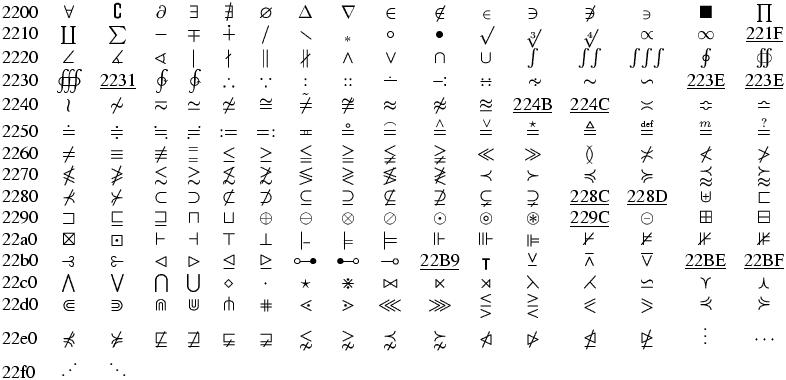
We consider here symbols between U+2300 and U+23FF. About 30 symbols are implemented. The table shows also some symbols between U+2600 and U+2607, and others between U+263D and U+2685.
$\begin{array}{lccccccccccccccccc}
\text{2300}& \unimp{2300}&\unimp{2301}&\unimp{2302}&\unimp{2303}&
\unimp{2304}&\mathbarwedge&\mathBarwed&\unimp{2307}&
\mathlceil&\mathrceil&\mathlfloor&\mathrfloor&
\mathdrcrop&\mathdlcrop&\mathurcrop&\mathulcrop\\
\text{2310}&\mathbnot& \unimp{2311}& \mathprofline&\mathprofsurf&
\unimp{2314}& \mathtelrec&\mathtarget&\unimp{2317}&
\unimp{2318}& \unimp{2319}& \unimp{231a}& \unimp{231b}&
\mathulcorner& \mathurcorner&\mathllcorner&\mathlrcorner\\
\text{2320}&\unimp{2320}&\unimp{2321}&\mathfrown&\mathsmile&
\unimp{2324}&\unimp{2325}&\unimp{2326}&\unimp{2327}&
\unimp{2328}&\mathlangle&\mathrangle&\unimp{232b}&
\unimp{232c}& \mathcylcty&\mathprofalar&\unimp{232f}\\
\text{2330}&&&&&&&\mathtopbot&&&\unimp{2339}&&&&
\mathovbar& &\mathsolbar\\
\text{2340}&\unimp{2340}&&&&&&&\unimp{2347}&\unimp{2348}\\
\text{2350}&\unimp{2350}&&&&&&&\unimp{2357}\\
\text{2600}&&\unimp{2601}&&&&\mathbigstar&\mathstar&&&&&&\unimp{260C}&
\unimp{260d}\unimp{263d}& \unimp{263e}&\unimp{263f}\\
\text{2640}&\mathfemale&\unimp{2641}&\mathmale&\unimp{2643}
&\unimp{2644}&\unimp{2645}&\unimp{2646}&\unimp{2647}&\unimp{2648}&
\unimp{2649}&\unimp{264A}&\unimp{264b}&\unimp{264c}&
\unimp{264d}&\unimp{264e} &\unimp{264f}\\
\text{2650}&\unimp{2650}&\unimp{2651}&\unimp{2652}&\unimp{2653}
&\unimp{2654}&\unimp{2655}&\unimp{2656}&\unimp{2657}&\unimp{2658}&
\unimp{2659}&\unimp{265A}&\unimp{265b}&\unimp{265c}&
\unimp{265d}&\unimp{265e} &\unimp{265f}\\
\text{2660}&\mathspadesuit&\unimp{2661}&\unimp{2662}&\mathclubsuit
&\unimp{2664}&\mathheartsuit&\mathdiamondsuit&\unimp{2667}&&
\unimp{2669}&\mathsung&&&
\mathflat&\mathnatur &\mathsharp\\
\text{2680}&\unimp{2680}&\unimp{2681}&\unimp{2682}&\unimp{2683}
&\unimp{2684}&\unimp{2685}\\
\end{array}$
This is the preview.
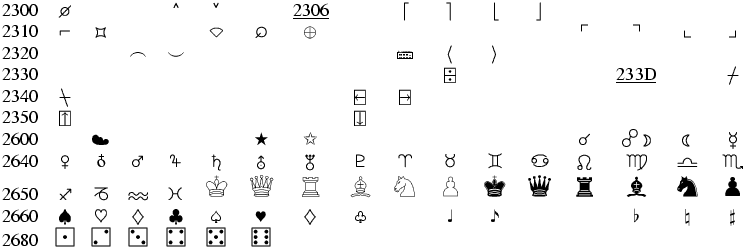
Symbols between U+1D400 and U+1D7FF. First part. There are 12 empty slots in the table symbols. These characters are somewhere else. They are marked by a plus sign.
$\begin{array}{lccccccccccccccccc}
\text{1d400}&\unimp{1d400}&\unimp{1d401}&\unimp{1d402}&\unimp{1d403}&
\unimp{1d404}&\unimp{1d405}&\unimp{1d406}&\unimp{1d407}&
\unimp{1d408}&\unimp{1d409}&\unimp{1d40a}&\unimp{1d40b}&
\unimp{1d40c}&\unimp{1d40d}&\unimp{1d40e}&\unimp{1d40f}\\
\text{1d410}&\unimp{1d410}&\unimp{1d411}&\unimp{1d412}&\unimp{1d413}&
\unimp{1d414}&\unimp{1d415}&\unimp{1d416}&\unimp{1d417}&
\unimp{1d418}&\unimp{1d419}&\unimp{1d41a}&\unimp{1d41b}&
\unimp{1d41c}&\unimp{1d41d}&\unimp{1d41e}&\unimp{1d41f}\\
\text{1d420}&\unimp{1d420}&\unimp{1d421}&\unimp{1d422}&\unimp{1d423}&
\unimp{1d424}&\unimp{1d425}&\unimp{1d426}&\unimp{1d427}&
\unimp{1d428}&\unimp{1d429}&\unimp{1d42a}&\unimp{1d42b}&
\unimp{1d42c}&\unimp{1d42d}&\unimp{1d42e}&\unimp{1d42f}\\
\text{1d430}&\unimp{1d430}&\unimp{1d431}&\unimp{1d432}&\unimp{1d433}&
\unimp{1d434}&\unimp{1d435}&\unimp{1d436}&\unimp{1d437}&
\unimp{1d438}&\unimp{1d439}&\unimp{1d43a}&\unimp{1d43b}&
\unimp{1d43c}&\unimp{1d43d}&\unimp{1d43e}&\unimp{1d43f}\\
\text{1d440}&\unimp{1d440}&\unimp{1d441}&\unimp{1d442}&\unimp{1d443}&
\unimp{1d444}&\unimp{1d445}&\unimp{1d446}&\unimp{1d447}&
\unimp{1d448}&\unimp{1d449}&\unimp{1d44a}&\unimp{1d44b}&
\unimp{1d44c}&\unimp{1d44d}&\unimp{1d44e}&\unimp{1d44f}\\
\text{1d450}&\unimp{1d450}&\unimp{1d451}&\unimp{1d452}&\unimp{1d453}&
\unimp{1d454}&+\unimp{210e}&\unimp{1d456}&\unimp{1d457}&
\unimp{1d458}&\unimp{1d459}&\unimp{1d45a}&\unimp{1d45b}&
\unimp{1d45c}&\unimp{1d45d}&\unimp{1d45e}&\unimp{1d45f}\\
\text{1d460}&\unimp{1d460}&\unimp{1d461}&\unimp{1d462}&\unimp{1d463}&
\unimp{1d464}&\unimp{1d465}&\unimp{1d466}&\unimp{1d467}&
\unimp{1d468}&\unimp{1d469}&\unimp{1d46a}&\unimp{1d46b}&
\unimp{1d46c}&\unimp{1d46d}&\unimp{1d46e}&\unimp{1d46f}\\
\text{1d470}&\unimp{1d470}&\unimp{1d471}&\unimp{1d472}&\unimp{1d473}&
\unimp{1d474}&\unimp{1d475}&\unimp{1d476}&\unimp{1d477}&
\unimp{1d478}&\unimp{1d479}&\unimp{1d47a}&\unimp{1d47b}&
\unimp{1d47c}&\unimp{1d47d}&\unimp{1d47e}&\unimp{1d47f}\\
\text{1d480}&\unimp{1d480}&\unimp{1d481}&\unimp{1d482}&\unimp{1d483}&
\unimp{1d484}&\unimp{1d485}&\unimp{1d486}&\unimp{1d487}&
\unimp{1d488}&\unimp{1d489}&\unimp{1d48a}&\unimp{1d48b}&
\unimp{1d48c}&\unimp{1d48d}&\unimp{1d48e}&\unimp{1d48f}\\
\text{1d490}&\unimp{1d490}&\unimp{1d491}&\unimp{1d492}&\unimp{1d493}&
\unimp{1d494}&\unimp{1d495}&\unimp{1d496}&\unimp{1d497}&
\unimp{1d498}&\unimp{1d499}&\unimp{1d49a}&\unimp{1d49b}&
\mathAscr&+\mathBscr&\mathCscr&\mathDscr\\
\text{1d4a0}&+\mathEscr&+\mathFscr&\mathGscr&+\mathHscr&
+\mathIscr&\mathJscr&\mathKscr&+\mathLscr&
+\mathMscr&\mathNscr&\mathOscr&\mathPscr&
\mathQscr&+\mathRscr&\mathSscr&\mathTscr\\
\text{1d4b0}&\mathUscr&\mathVscr&\mathWscr&\mathXscr&
\mathYscr&\mathZscr&\mathascr&\mathbscr&
\mathcscr&\mathdscr&+\mathescr&\mathfscr&
+\mathgscr&\mathhscr&\mathiscr&\mathjscr\\
\text{1d4c0}&\mathkscr&\mathlscr&\mathmscr&\mathnscr&
+\mathoscr&\mathpscr&\mathqscr&\mathrscr&
\mathsscr&\mathtscr&\mathuscr&\mathvscr&
\mathwscr&\mathxscr&\mathyscr&\mathzscr\\
\text{1d4d0}&\unimp{1d4d0}&\unimp{1d4d1}&\unimp{1d4d2}&\unimp{1d4d3}&
\unimp{1d4d4}&\unimp{1d4d5}&\unimp{1d4d6}&\unimp{1d4d7}&
\unimp{1d4d8}&\unimp{1d4d9}&\unimp{1d4da}&\unimp{1d4db}&
\unimp{1d4dc}&\unimp{1d4dd}&\unimp{1d4de}&\unimp{1d4df}\\
\text{1d4e0}&\unimp{1d4e0}&\unimp{1d4e1}&\unimp{1d4e2}&\unimp{1d4e3}&
\unimp{1d4e4}&\unimp{1d4e5}&\unimp{1d4e6}&\unimp{1d4e7}&
\unimp{1d4e8}&\unimp{1d4e9}&\unimp{1d4ea}&\unimp{1d4eb}&
\unimp{1d4ec}&\unimp{1d4ed}&\unimp{1d4ee}&\unimp{1d4ef}\\
\text{1d4f0}&\unimp{1d4f0}&\unimp{1d4f1}&\unimp{1d4f2}&\unimp{1d4f3}&
\unimp{1d4f4}&\unimp{1d4f5}&\unimp{1d4f6}&\unimp{1d4f7}&
\unimp{1d4f8}&\unimp{1d4f9}&\unimp{1d4fa}&\unimp{1d4fb}&
\unimp{1d4fc}&\unimp{1d4fd}&\unimp{1d4fe}&\unimp{1d4ff}\\
\end{array}$
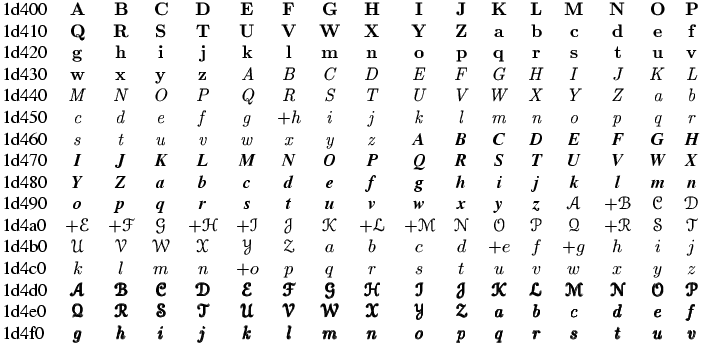
$\begin{array}{lccccccccccccccccc}
\text{1d500}&\unimp{1d500}&\unimp{1d501}&\unimp{1d502}&\unimp{1d503}&
\mathAfr&\mathBfr&+\mathCfr&\mathDfr&
\mathEfr&\mathFfr&\mathGfr&+\mathHfr&
+\mathIfr&\mathJfr&\mathKfr&\mathLfr\\
\text{1d510}&\mathMfr&\mathNfr&\mathOfr&\mathPfr&
\mathQfr&+\mathRfr&\mathSfr&\mathTfr&
\mathUfr&\mathVfr&\mathWfr&\mathXfr&
\mathYfr&+\mathZfr&\mathafr&\mathbfr\\
\text{1d520}&\mathcfr&\mathdfr&\mathefr&\mathffr&
\mathgfr&\mathhfr&\mathifr&\mathjfr&
\mathkfr&\mathlfr&\mathmfr&\mathnfr&
\mathofr&\mathpfr&\mathqfr&\mathrfr\\
\text{1d530}&\mathsfr&\mathtfr&\mathufr&\mathvfr&
\mathwfr&\mathxfr&\mathyfr&\mathzfr&
\mathAopf&\mathBopf&+\mathCopf&\mathDopf&
\mathEopf&\mathFopf&\mathGopf&+\mathHopf\\
\text{1d540}&\mathIopf&\mathJopf&\mathKopf&\mathLopf&
\mathMopf&+\mathNopf&\mathOopf&+\mathPopf&
+\mathQopf&+\mathRopf&\mathSopf&\mathTopf&
\mathUopf&\mathVopf&\mathWopf&\mathXopf\\
\text{1d550}&\mathYopf&+\mathZopf&\mathaopf&\mathbopf&
\mathcopf&\mathdopf&\matheopf&\mathfopf&
\mathgopf&\mathhopf&\mathiopf&\mathjopf&
\mathkopf&\mathlopf&\mathmopf&\mathnopf\\
\text{1d560}&\mathoopf&\mathpopf&\mathqopf&\mathropf&
\mathsopf&\mathtopf&\mathuopf&\mathvopf&
\mathwopf&\mathxopf&\mathyopf&\mathzopf&
\unimp{1d56c}&\unimp{1d56d}&\unimp{1d56e}&\unimp{1d56f}\\
\text{1d570}&\unimp{1d570}&\unimp{1d571}&\unimp{1d572}&\unimp{1d573}&
\unimp{1d574}&\unimp{1d575}&\unimp{1d576}&\unimp{1d577}&
\unimp{1d578}&\unimp{1d579}&\unimp{1d57a}&\unimp{1d57b}&
\unimp{1d57c}&\unimp{1d57d}&\unimp{1d57e}&\unimp{1d57f}\\
\text{1d580}&\unimp{1d580}&\unimp{1d581}&\unimp{1d582}&\unimp{1d583}&
\unimp{1d584}&\unimp{1d585}&\unimp{1d586}&\unimp{1d587}&
\unimp{1d588}&\unimp{1d589}&\unimp{1d58a}&\unimp{1d58b}&
\unimp{1d58c}&\unimp{1d58d}&\unimp{1d58e}&\unimp{1d58f}\\
\text{1d590}&\unimp{1d590}&\unimp{1d591}&\unimp{1d592}&\unimp{1d593}&
\unimp{1d594}&\unimp{1d595}&\unimp{1d596}&\unimp{1d597}&
\unimp{1d598}&\unimp{1d599}&\unimp{1d59a}&\unimp{1d59b}&
\unimp{1d59c}&\unimp{1d59d}&\unimp{1d59e}&\unimp{1d59f}\\
\text{1d5a0}&\unimp{1d5a0}&\unimp{1d5a1}&\unimp{1d5a2}&\unimp{1d5a3}&
\unimp{1d5a4}&\unimp{1d5a5}&\unimp{1d5a6}&\unimp{1d5a7}&
\unimp{1d5a8}&\unimp{1d5a9}&\unimp{1d5aa}&\unimp{1d5ab}&
\unimp{1d5ac}&\unimp{1d5ad}&\unimp{1d5ae}&\unimp{1d5af}\\
\text{1d5b0}&\unimp{1d5b0}&\unimp{1d5b1}&\unimp{1d5b2}&\unimp{1d5b3}&
\unimp{1d5b4}&\unimp{1d5b5}&\unimp{1d5b6}&\unimp{1d5b7}&
\unimp{1d5b8}&\unimp{1d5b9}&\unimp{1d5ba}&\unimp{1d5bb}&
\unimp{1d5bc}&\unimp{1d5bd}&\unimp{1d5be}&\unimp{1d5af}\\
\text{1d5c0}&\unimp{1d5c0}&\unimp{1d5c1}&\unimp{1d5c2}&\unimp{1d5c3}&
\unimp{1d5c4}&\unimp{1d5c5}&\unimp{1d5c6}&\unimp{1d5c7}&
\unimp{1d5c8}&\unimp{1d5c9}&\unimp{1d5ca}&\unimp{1d5cb}&
\unimp{1d5cc}&\unimp{1d5cd}&\unimp{1d5ce}&\unimp{1d5cf}\\
\text{1d5d0}&\unimp{1d5d0}&\unimp{1d5d1}&\unimp{1d5d2}&\unimp{1d5d3}&
\unimp{1d5d4}&\unimp{1d5d5}&\unimp{1d5d6}&\unimp{1d5d7}&
\unimp{1d5d8}&\unimp{1d5d9}&\unimp{1d5da}&\unimp{1d5db}&
\unimp{1d5dc}&\unimp{1d5dd}&\unimp{1d5de}&\unimp{1d5df}\\
\text{1d5e0}&\unimp{1d5e0}&\unimp{1d5e1}&\unimp{1d5e2}&\unimp{1d5e3}&
\unimp{1d5e4}&\unimp{1d5e5}&\unimp{1d5e6}&\unimp{1d5e7}&
\unimp{1d5e8}&\unimp{1d5e9}&\unimp{1d5ea}&\unimp{1d5eb}&
\unimp{1d5ec}&\unimp{1d5ed}&\unimp{1d5ee}&\unimp{1d5ef}\\
\text{1d5f0}&\unimp{1d5f0}&\unimp{1d5f1}&\unimp{1d5f2}&\unimp{1d5f3}&
\unimp{1d5f4}&\unimp{1d5f5}&\unimp{1d5f6}&\unimp{1d5f7}&
\unimp{1d5f8}&\unimp{1d5f9}&\unimp{1d5fa}&\unimp{1d5fb}&
\unimp{1d5fc}&\unimp{1d5fd}&\unimp{1d5fe}&\unimp{1d5ff}\\
\end{array}$
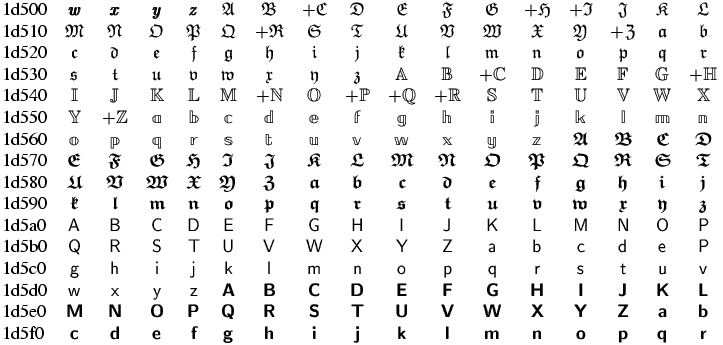
$\begin{array}{lccccccccccccccccc}
\text{1d600}&\unimp{1d600}&\unimp{1d601}&\unimp{1d602}&\unimp{1d603}&
\unimp{1d604}&\unimp{1d605}&\unimp{1d606}&\unimp{1d607}&
\unimp{1d608}&\unimp{1d609}&\unimp{1d60a}&\unimp{1d60b}&
\unimp{1d60c}&\unimp{1d60d}&\unimp{1d60e}&\unimp{1d60f}\\
\text{1d610}&\unimp{1d610}&\unimp{1d611}&\unimp{1d612}&\unimp{1d613}&
\unimp{1d614}&\unimp{1d615}&\unimp{1d616}&\unimp{1d617}&
\unimp{1d618}&\unimp{1d619}&\unimp{1d61a}&\unimp{1d61b}&
\unimp{1d61c}&\unimp{1d61d}&\unimp{1d61e}&\unimp{1d61f}\\
\text{1d620}&\unimp{1d620}&\unimp{1d621}&\unimp{1d622}&\unimp{1d623}&
\unimp{1d624}&\unimp{1d625}&\unimp{1d626}&\unimp{1d627}&
\unimp{1d628}&\unimp{1d629}&\unimp{1d62a}&\unimp{1d62b}&
\unimp{1d62c}&\unimp{1d62d}&\unimp{1d62e}&\unimp{1d62f}\\
\text{1d630}&\unimp{1d630}&\unimp{1d631}&\unimp{1d632}&\unimp{1d633}&
\unimp{1d634}&\unimp{1d635}&\unimp{1d636}&\unimp{1d637}&
\unimp{1d638}&\unimp{1d639}&\unimp{1d63a}&\unimp{1d63b}&
\unimp{1d63c}&\unimp{1d63d}&\unimp{1d63e}&\unimp{1d63f}\\
\text{1d640}&\unimp{1d640}&\unimp{1d641}&\unimp{1d642}&\unimp{1d643}&
\unimp{1d644}&\unimp{1d645}&\unimp{1d646}&\unimp{1d647}&
\unimp{1d648}&\unimp{1d649}&\unimp{1d64a}&\unimp{1d64b}&
\unimp{1d64c}&\unimp{1d64d}&\unimp{1d64e}&\unimp{1d64f}\\
\text{1d650}&\unimp{1d650}&\unimp{1d651}&\unimp{1d652}&\unimp{1d653}&
\unimp{1d654}&\unimp{1d655}&\unimp{1d656}&\unimp{1d657}&
\unimp{1d658}&\unimp{1d659}&\unimp{1d65a}&\unimp{1d65b}&
\unimp{1d65c}&\unimp{1d65d}&\unimp{1d65e}&\unimp{1d65f}\\
\text{1d660}&\unimp{1d660}&\unimp{1d661}&\unimp{1d662}&\unimp{1d663}&
\unimp{1d664}&\unimp{1d665}&\unimp{1d666}&\unimp{1d667}&
\unimp{1d668}&\unimp{1d669}&\unimp{1d66a}&\unimp{1d66b}&
\unimp{1d66c}&\unimp{1d66d}&\unimp{1d66e}&\unimp{1d66f}\\
\text{1d670}&\unimp{1d670}&\unimp{1d671}&\unimp{1d672}&\unimp{1d673}&
\unimp{1d674}&\unimp{1d675}&\unimp{1d676}&\unimp{1d677}&
\unimp{1d678}&\unimp{1d679}&\unimp{1d67a}&\unimp{1d67b}&
\unimp{1d67c}&\unimp{1d67d}&\unimp{1d67e}&\unimp{1d67f}\\
\text{1d670}&\unimp{1d670}&\unimp{1d671}&\unimp{1d672}&\unimp{1d673}&
\unimp{1d674}&\unimp{1d675}&\unimp{1d676}&\unimp{1d677}&
\unimp{1d678}&\unimp{1d679}&\unimp{1d67a}&\unimp{1d67b}&
\unimp{1d67c}&\unimp{1d67d}&\unimp{1d67e}&\unimp{1d67f}\\
\text{1d680}&\unimp{1d680}&\unimp{1d681}&\unimp{1d682}&\unimp{1d683}&
\unimp{1d684}&\unimp{1d685}&\unimp{1d686}&\unimp{1d687}&
\unimp{1d688}&\unimp{1d689}&\unimp{1d68a}&\unimp{1d68b}&
\unimp{1d68c}&\unimp{1d68d}&\unimp{1d68e}&\unimp{1d68f}\\
\text{1d690}&\unimp{1d690}&\unimp{1d691}&\unimp{1d692}&\unimp{1d693}&
\unimp{1d694}&\unimp{1d695}&\unimp{1d696}&\unimp{1d697}&
\unimp{1d698}&\unimp{1d699}&\unimp{1d69a}&\unimp{1d69b}&
\unimp{1d69c}&\unimp{1d69d}&\unimp{1d69e}&\unimp{1d69f}\\
\text{1d6a0}&\unimp{1d6a0}&\unimp{1d6a1}&\unimp{1d6a2}&\unimp{1d6a3}&
&&&&
\unimp{1d6a8}&\unimp{1d6a9}&\unimp{1d6aa}&\unimp{1d6ab}&
\unimp{1d6ac}&\unimp{1d6ad}&\unimp{1d6ae}&\unimp{1d6af}\\
\text{1d6b0}&\unimp{1d6b0}&\unimp{1d6b1}&\unimp{1d6b2}&\unimp{1d6b3}&
\unimp{1d6b4}&\unimp{1d6b5}&\unimp{1d6b6}&\unimp{1d6b7}&
\unimp{1d6b8}&\unimp{1d6b9}&\unimp{1d6ba}&\unimp{1d6bb}&
\unimp{1d6bc}&\unimp{1d6bd}&\unimp{1d6be}&\unimp{1d6bf}\\
\text{1d6c0}&\unimp{1d6c0}&\unimp{1d6c1}&\unimp{1d6c2}&\unimp{1d6c3}&
\unimp{1d6c4}&\unimp{1d6c5}&\unimp{1d6c6}&\unimp{1d6c7}&
\unimp{1d6c8}&\unimp{1d6c9}&\unimp{1d6ca}&\unimp{1d6cb}&
\unimp{1d6cc}&\unimp{1d6cd}&\unimp{1d6ce}&\unimp{1d6cf}\\
\text{1d6d0}&\unimp{1d6d0}&\unimp{1d6d1}&\unimp{1d6d2}&\unimp{1d6d3}&
\unimp{1d6d4}&\unimp{1d6d5}&\unimp{1d6d6}&\unimp{1d6d7}&
\unimp{1d6d8}&\unimp{1d6d9}&\unimp{1d6da}&\unimp{1d6db}&
\unimp{1d6dc}&\unimp{1d6dd}&\unimp{1d6de}&\unimp{1d6df}\\
\text{1d6e0}&\unimp{1d6e0}&\unimp{1d6e1}&\unimp{1d6e2}&\unimp{1d6e3}&
\unimp{1d6e4}&\unimp{1d6e5}&\unimp{1d6e6}&\unimp{1d6e7}&
\unimp{1d6e8}&\unimp{1d6e9}&\unimp{1d6ea}&\unimp{1d6eb}&
\unimp{1d6ec}&\unimp{1d6ed}&\unimp{1d6ee}&\unimp{1d6ef}\\
\text{1d6f0}&\unimp{1d6f0}&\unimp{1d6f1}&\unimp{1d6f2}&\unimp{1d6f3}&
\unimp{1d6f4}&\unimp{1d6f5}&\unimp{1d6f6}&\unimp{1d6f7}&
\unimp{1d6f8}&\unimp{1d6f9}&\unimp{1d6fa}&\unimp{1d6fb}&
\unimp{1d6fc}&\unimp{1d6fd}&\unimp{1d6fe}&\unimp{1d6ff}\\
\end{array}$
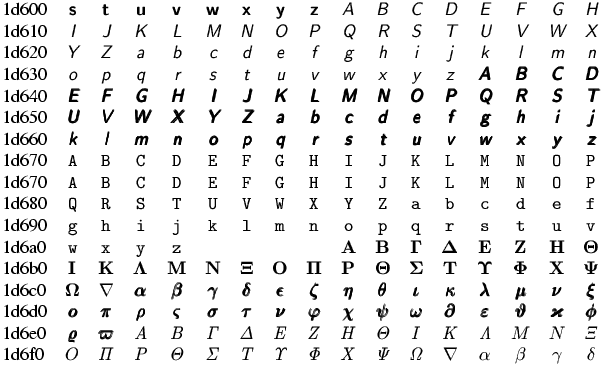
\text{1d700}&\unimp{1d700}&\unimp{1d701}&\unimp{1d702}&\unimp{1d703}&
\unimp{1d704}&\unimp{1d705}&\unimp{1d706}&\unimp{1d707}&
\unimp{1d708}&\unimp{1d709}&\unimp{1d70a}&\unimp{1d70b}&
\unimp{1d70c}&\unimp{1d70d}&\unimp{1d70e}&\unimp{1d70f}\\
\text{1d710}&\unimp{1d710}&\unimp{1d711}&\unimp{1d712}&\unimp{1d713}&
\unimp{1d714}&\unimp{1d715}&\unimp{1d716}&\unimp{1d717}&
\unimp{1d718}&\unimp{1d719}&\unimp{1d71a}&\unimp{1d71b}&
\unimp{1d71c}&\unimp{1d71d}&\unimp{1d71e}&\unimp{1d71f}\\
\text{1d720}&\unimp{1d720}&\unimp{1d721}&\unimp{1d722}&\unimp{1d723}&
\unimp{1d724}&\unimp{1d725}&\unimp{1d726}&\unimp{1d727}&
\unimp{1d728}&\unimp{1d729}&\unimp{1d72a}&\unimp{1d72b}&
\unimp{1d72c}&\unimp{1d72d}&\unimp{1d72e}&\unimp{1d72f}\\
\text{1d730}&\unimp{1d730}&\unimp{1d731}&\unimp{1d732}&\unimp{1d733}&
\unimp{1d734}&\unimp{1d735}&\unimp{1d736}&\unimp{1d737}&
\unimp{1d738}&\unimp{1d739}&\unimp{1d73a}&\unimp{1d73b}&
\unimp{1d73c}&\unimp{1d73d}&\unimp{1d73e}&\unimp{1d73f}\\
\text{1d740}&\unimp{1d740}&\unimp{1d741}&\unimp{1d742}&\unimp{1d743}&
\unimp{1d744}&\unimp{1d745}&\unimp{1d746}&\unimp{1d747}&
\unimp{1d748}&\unimp{1d749}&\unimp{1d74a}&\unimp{1d74b}&
\unimp{1d74c}&\unimp{1d74d}&\unimp{1d74e}&\unimp{1d74f}\\
\text{1d750}&\unimp{1d750}&\unimp{1d751}&\unimp{1d752}&\unimp{1d753}&
\unimp{1d754}&\unimp{1d755}&\unimp{1d756}&\unimp{1d757}&
\unimp{1d758}&\unimp{1d759}&\unimp{1d75a}&\unimp{1d75b}&
\unimp{1d75c}&\unimp{1d75d}&\unimp{1d75e}&\unimp{1d75f}\\
\text{1d760}&\unimp{1d760}&\unimp{1d761}&\unimp{1d762}&\unimp{1d763}&
\unimp{1d764}&\unimp{1d765}&\unimp{1d766}&\unimp{1d767}&
\unimp{1d768}&\unimp{1d769}&\unimp{1d76a}&\unimp{1d76b}&
\unimp{1d76c}&\unimp{1d76d}&\unimp{1d76e}&\unimp{1d76f}\\
\text{1d7c0}&&&&& &&&&&&&&
&&\unimp{1d7ce}&\unimp{1d7cf}\\
\text{1d7d0}&\unimp{1d7d0}&\unimp{1d7d1}&\unimp{1d7d2}&\unimp{1d7d3}&
\unimp{1d7d4}&\unimp{1d7d5}&\unimp{1d7d6}&\unimp{1d7d7}&
\unimp{1d7d8}&\unimp{1d7d9}&\unimp{1d7da}&\unimp{1d7db}&
\unimp{1d7dc}&\unimp{1d7dd}&\unimp{1d7de}&\unimp{1d7df}\\
\text{1d7e0}&\unimp{1d7e0}&\unimp{1d7e1}&\unimp{1d7e2}&\unimp{1d7e3}&
\unimp{1d7e4}&\unimp{1d7e5}&\unimp{1d7e6}&\unimp{1d7e7}&
\unimp{1d7e8}&\unimp{1d7e9}&\unimp{1d7ea}&\unimp{1d7eb}&
\unimp{1d7ec}&\unimp{1d7ed}&\unimp{1d7ee}&\unimp{1d7ef}\\
\text{1d7f0}&\unimp{1d7f0}&\unimp{1d7f1}&\unimp{1d7f2}&\unimp{1d7f3}&
\unimp{1d7f4}&\unimp{1d7f5}&\unimp{1d7f6}&\unimp{1d7f7}&
\unimp{1d7f8}&\unimp{1d7f9}&\unimp{1d7fa}&\unimp{1d7fb}&
\unimp{1d7fc}&\unimp{1d7fd}&\unimp{1d7fe}&\unimp{1d7ff}\\
\end{array}$
Some characters are missing:
sans serif bold greek lower case
sans serif bold greek italic
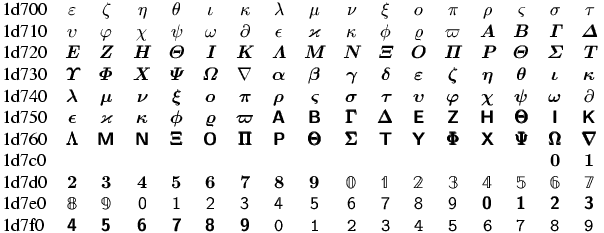
For some encodings, Tralics proposes a conversion to UTF8. The name of the command has the form T1-encoding, hence cannot be used directly; see below how to alias it to, say, \foo. The command reads an argument that must be an integer, for instance \foo{65}, \foo{'101} , \foo{"41}, \foo{`A}, \foo{\count0} (the braces are mandatory). The expansion is of the form \char128. This is a single token, as produced by \chardef. In the T1 encoding, hex location DF contains "SS", but this is not a Unicode character, thus provokes an error; character with position less than 32 are not translated. The argument
\expandafter\let\expandafter\enc\csname T1-encoding\endcsname
\enc{"20}\enc{"21}\enc{"22}\enc{"23}\enc{"24}\enc{"25}\enc{"26}\enc{"27}%
\enc{"28}\enc{"29}\enc{"2A}\enc{"2B}\enc{"2C}\enc{"2D}\enc{"2E}\enc{"2F}
\enc{"30}\enc{"31}\enc{"32}\enc{"33}\enc{"34}\enc{"35}\enc{"36}\enc{"37}%
\enc{"38}\enc{"39}\enc{"3A}\enc{"3B}\enc{"3C}\enc{"3D}\enc{"3E}\enc{"3F}
\enc{"40}\enc{"41}\enc{"42}\enc{"43}\enc{"44}\enc{"45}\enc{"46}\enc{"47}%
\enc{"48}\enc{"49}\enc{"4A}\enc{"4B}\enc{"4C}\enc{"4D}\enc{"4E}\enc{"4F}
\enc{"50}\enc{"51}\enc{"52}\enc{"53}\enc{"54}\enc{"55}\enc{"56}\enc{"57}%
\enc{"58}\enc{"59}\enc{"5A}\enc{"5B}\enc{"5C}\enc{"5D}\enc{"5E}\enc{"5F}
\enc{"60}\enc{"61}\enc{"62}\enc{"63}\enc{"64}\enc{"65}\enc{"66}\enc{"67}%
\enc{"68}\enc{"69}\enc{"6A}\enc{"6B}\enc{"6C}\enc{"6D}\enc{"6E}\enc{"6F}
\enc{"70}\enc{"71}\enc{"72}\enc{"73}\enc{"74}\enc{"75}\enc{"76}\enc{"77}%
\enc{"78}\enc{"79}\enc{"7A}\enc{"7B}\enc{"7C}\enc{"7D}\enc{"7E}\enc{"7F}
\enc{"80}\enc{"81}\enc{"82}\enc{"83}\enc{"84}\enc{"85}\enc{"86}\enc{"87}%
\enc{"88}\enc{"89}\enc{"8A}\enc{"8B}\enc{"8C}\enc{"8D}\enc{"8E}\enc{"8F}
\enc{"90}\enc{"91}\enc{"92}\enc{"93}\enc{"94}\enc{"95}\enc{"96}\enc{"97}%
\enc{"98}\enc{"99}\enc{"9A}\enc{"9B}\enc{"9C}\enc{"9D}\enc{"9E}\enc{"9F}
\enc{"A0}\enc{"A1}\enc{"A2}\enc{"A3}\enc{"A4}\enc{"A5}\enc{"A6}\enc{"A7}%
\enc{"A8}\enc{"A9}\enc{"AA}\enc{"AB}\enc{"AC}\enc{"AD}\enc{"AE}\enc{"AF}
\enc{"B0}\enc{"B1}\enc{"B2}\enc{"B3}\enc{"B4}\enc{"B5}\enc{"B6}\enc{"B7}%
\enc{"B8}\enc{"B9}\enc{"BA}\enc{"BB}\enc{"BC}\enc{"BD}\enc{"BE}\enc{"BF}
\enc{"C0}\enc{"C1}\enc{"C2}\enc{"C3}\enc{"C4}\enc{"C5}\enc{"C6}\enc{"C7}%
\enc{"C8}\enc{"C9}\enc{"CA}\enc{"CB}\enc{"CC}\enc{"CD}\enc{"CE}\enc{"CF}
\enc{"D0}\enc{"D1}\enc{"D2}\enc{"D3}\enc{"D4}\enc{"D5}\enc{"D6}\enc{"D7}%"
\enc{"D8}\enc{"D9}\enc{"DA}\enc{"DB}\enc{"DC}\enc{"DD}\enc{"DE}
\enc{"E0}\enc{"E1}\enc{"E2}\enc{"E3}\enc{"E4}\enc{"E5}\enc{"E6}\enc{"E7}%
\enc{"E8}\enc{"E9}\enc{"EA}\enc{"EB}\enc{"EC}\enc{"ED}\enc{"EE}\enc{"EF}
\enc{"F0}\enc{"F1}\enc{"F2}\enc{"F3}\enc{"F4}\enc{"F5}\enc{"F6}\enc{"F7}%
\enc{"F8}\enc{"F9}\enc{"FA}\enc{"FB}\enc{"FC}\enc{"FD}\enc{"FE}\enc{"FF}
Translation
␣!"#$%&'()*+,-./
0123456789:;<=>?
@ABCDEFGHIJKLMNO
PQRSTUVWXYZ[\]^_
`abcdefghijklmno
pqrstuvwxyz{|}~-
ĂĄĆČĎĚĘĞĹĽŁŇŃŊŐŔ
ŘŚŠŞŤŢŰŮŸŹŽŻIJİđ§
ăąćčďěęğĺľłńňŋőŕ
řśšşťţűůÿźžżij¡¿£
ÀÁÂÃÄÅÆÇÈÉÊËÌÍÎÏ
ÐÑÒÓÔÕÖŒØÙÚÛÜÝÞ
àáâãäåæçèéêëìíîï
ðñòóôõöœøùúûüýþß
The command \OT2-encoding (and its alias \wncyr-encoding) describes the OT2 (cyrillic) encoding. This is a 7bit alphabet, and we show all the 128 characters, in order. Some of these characters are accents, hence placed on the character that precedes (or in the margin).
ЊЉЏЭІЄЂЋњљџэієђћ ЮЖЙЁѴѲЅЯюжйёѵѳѕя ̈!”Ѣ̆%́’()*ѣ,-./ 0123456789:;«¹»? ̆АБЦДЕФГХИЈКЛМНО ПЧРСТУВЩШЫЗ[“]ЬЪ ‘абцдефгхијклмно пчрстувщшыз-—№ьъ
The command \OT1-encoding describes the OT1 encoding. This is a 7bit alphabet, and some slots contain accent and ligatures; they are not implemented, and marked by a red x in the table that follows.
ΓΔΘΛΞΠΣΥΦΨΩxxxxx xxxxxxxxxßæœøÆŒØ x!"#$%&'()*+,-./ 0123456789:;¡=¿? @ABCDEFGHIJKLMNO PQRSTUVWXYZ[x]xx `abcdefghijklmno pqrstuvwxyzxxxxx
Not all characters are available. In particular cyrillic letters are missing. Some characters, like \'\AE are recognized, but not shown in the tables.
back to home page
© INRIA 2004, 2006
Last modified $Date: 2015/12/02 13:02:27 $